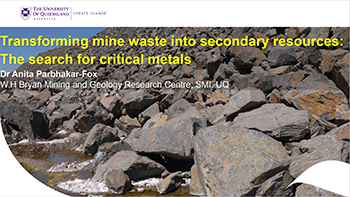Background and challenges
The industry-wide trend towards mining larger, lower grade ores ultimately results in a net increase in the quantities of waste produced (Mudd and Jowitt, 2018). For many ore deposit types resulting mine waste materials may contain sulphides (e.g., pyrite and pyrrhotite) which under surficial conditions, will oxidise to produce sulphuric acid by processes collectively termed acid and metalliferous drainage (AMD). If this acidic drainage enters surface and ground waters, there is potential for metals/metalloids, at deleterious concentrations, to be introduced into surrounding ecosystems and ultimately become bioaccessible to humans. Currently, there is significant pressure on the mining industry to improve methodologies for predicting the behaviour of future mine wastes, in order to protect communities and reduce liabilities when the mine reaches the end of its life, as indicated by the social licence to operate having been identified as the top risk posed to the mining industry for 2019 (Ernest Young, 2019).
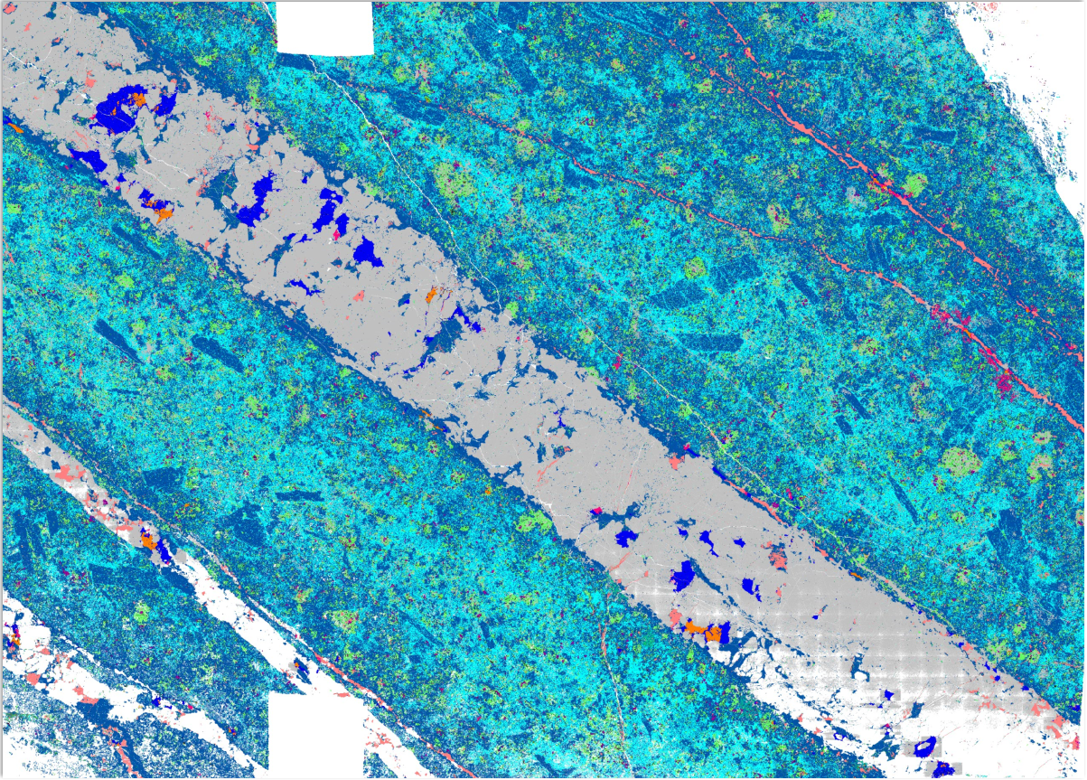 Conventionally, to predict the behaviour of mine waste material, two types of test work can be undertaken: static (short term, low-cost) and kinetic (longer term, high-cost) tests. Static tests comprise a range of chemical tests which involve the determination of sulphur or sulphide-sulphur to calculate maximum potential acidity (MPA; using stoichiometric factors derived from pyrite oxidation reactions) and the titration of a sample to calculate its acid neutralising capacity (ANC). Subtraction of ANC from MPA gives the net acid producing potential (NAPP) which enables waste classification (based on the absolute acid forming potential), particularly when screened against net acid generation (NAG) pH values (Dold, 2017). Kinetic testing produces more reliable information for predicting the long-term water chemistry and features two main types of testing: humidity cell (e.g., Brough et al., 2018) and column leach (e.g., Qian et al., 2017). However, this information is generated over a longer time scale (i.e., the minimum a test can run is 20 weeks) and, due to the costs involved, few are performed. They can also be terminated too early, therefore the resulting data may be of questionable accuracy and not effectively included in mine planning decisions.
Conventionally, to predict the behaviour of mine waste material, two types of test work can be undertaken: static (short term, low-cost) and kinetic (longer term, high-cost) tests. Static tests comprise a range of chemical tests which involve the determination of sulphur or sulphide-sulphur to calculate maximum potential acidity (MPA; using stoichiometric factors derived from pyrite oxidation reactions) and the titration of a sample to calculate its acid neutralising capacity (ANC). Subtraction of ANC from MPA gives the net acid producing potential (NAPP) which enables waste classification (based on the absolute acid forming potential), particularly when screened against net acid generation (NAG) pH values (Dold, 2017). Kinetic testing produces more reliable information for predicting the long-term water chemistry and features two main types of testing: humidity cell (e.g., Brough et al., 2018) and column leach (e.g., Qian et al., 2017). However, this information is generated over a longer time scale (i.e., the minimum a test can run is 20 weeks) and, due to the costs involved, few are performed. They can also be terminated too early, therefore the resulting data may be of questionable accuracy and not effectively included in mine planning decisions.
This is particularly important for the industry because inert (waste rock) material removed during the operation is used in the construction of the tailing’s wall. Consequently, this material must comply with specific geotechnical and geochemical characteristics that guarantee its physical and geochemical stability.
The current mine waste characterization strategy at many mine operations is based on a double step process. First, prior to blasting, one well every 35 m are sampled, where the sampled material is characterized as follows:
- Effervescence test with acid to estimate the carbonates amount.
- Visual test to estimate the amount of pyrite with previous concentration in a washing dish.
- Magnetic separation with magnetized pencil and estimation of the amount of magnetite.
Based on these estimates, geologists determine if the material is PAF and define its destination (dam wall or waste rock pile).
In parallel, the same sample is sent to an external laboratory where it is pulverized and analysed for its NAG pH and some samples are additionally analysed in another commercial laboratory for ABA test.
Limitation of current tests
As described in Parbhakar-Fox and Lottermoser (2015) the failure to accurately predict AMD leads to long-term impacts on ecosystems and human health, in addition to substantial financial consequences and reputational damage to operators. Whilst representing current best pratice, these well-established chemical tests and practices have inherent limitations, for example: (i) appropriate sampling is not pursued; (ii) risk assessments rely on limited static and kinetic test data, thus compromising the accuracy of resulting AMD block models; (iii) static tests are completed off-site and do not reflect actual field measurements; (iv) kinetic test data do not become available until later stages of mine development; (v) waste classification schemes generally categorise materials as only three types (i.e., PAF, NAF and UC) with other drainage forms (e.g., neutral metalliferous or saline) not considered; and (vi) conventional testing fails to consider that reactivity of waste is controlled by parameters other than chemistry (e.g., microbiology, type and occurrence of minerals, texture and hardness). Thus, accurate prediction is challenging because of the multifaceted processes leading to AMD. Waste assessments must assess mineralogical, textural and geometallurgical properties with this data used to interpret static or kinetic chemical data. Thus the industry requires a new matrix for staged AMD testing. Better AMD forecasting must start with improving the definition of geoenvironmental domains. Next, a range of low-cost and rapid tests embracing new technologies for the screening of samples should be conducted on site prior to the performance of established tests and advanced analyses using state-of-the-art techniques. Such an approach to AMD prediction would support more accurate and cost-effective waste management during operation, and ultimately less costly mine closure outcomes.
The Solution
Ideally, the mining industry needs to have a field-appropriate mine waste characterization/ARD prediction toolbox that collects useful data more time-efficiently and cost-effectively. If such tests can be readily performed at mine sites, then samples for more detailed ARD test work can be better chosen. By adapting the ‘geometallurgy matrix’ approach proposed by the AMIRA P843 GeM Project, the approach to mine waste characterisation can be rethought as shown in Figure 1.
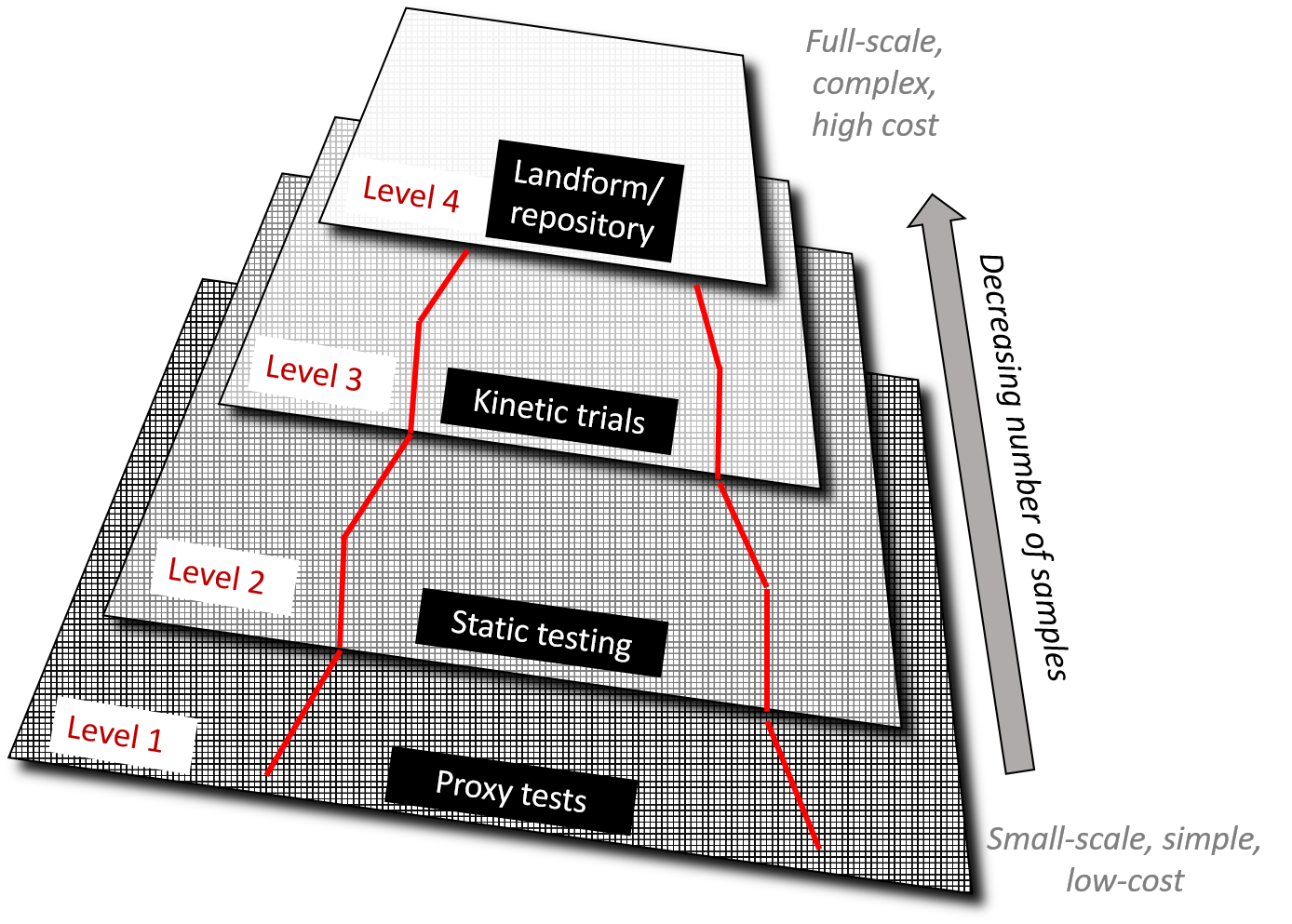
Researchers have developed several test methods that are lower cost (low cost, simple field techniques) which feature in our new Environmental Geometallurgy toolbox. These enable better sampling at Level 1 of the Environmental Geometallurgy Matrix approach. Further, they assist with waste domaining/ARD forecasting and facilitate improved sample selection for Level 2 testing. The new toolbox comprises of six main tools as shown in Figure 2.
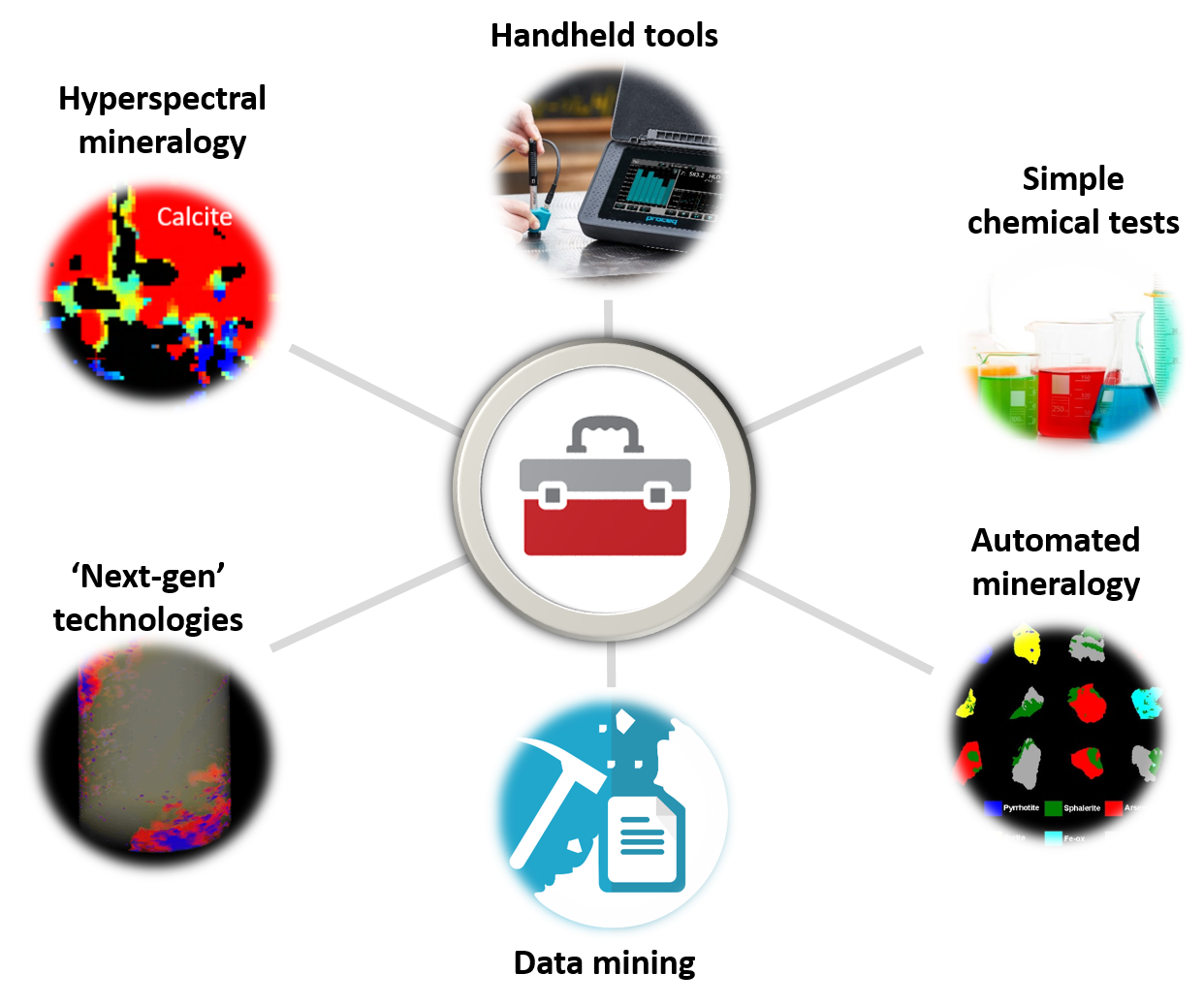
These methods have been tested using drill core and waste materials collected from several Australian mine sites in both Tasmania and Queensland. Table 1 provides a description of these tools and examples of their use.
Next Step
For each study site nominated by an industry partner, a review of the mine database or any other existing data will be undertaken from which we will develop a work program that adopts our Environmental Geometallurgy Matrix approach and applies the relevant tools from the toolbox to effectively identify waste domains and assist with building this knowledge into the database to enable accurate ARD block modelling. This will involve:
- Phase 1. The research team spending time on site with geologists to understand the deposit geology and examining the existing data to identify where the knowledge gaps are in the ARD models and to develop a sampling and analytical program to overcome these.
- Phase 2. Undertake the sampling program at the site.
- Phase 3. Perform various laboratory analyses (including validation testing with select Level 2 testing as per the Environmental Geometallurgy Matrix performed) to determine the application of the toolkit and measure the geoenvironmental properties of the sampled waste materials.
- Phase 4. Deliver results back to site and also undertake training workshops on how to use the toolkit therefore embedding the approach into routine operational practice.
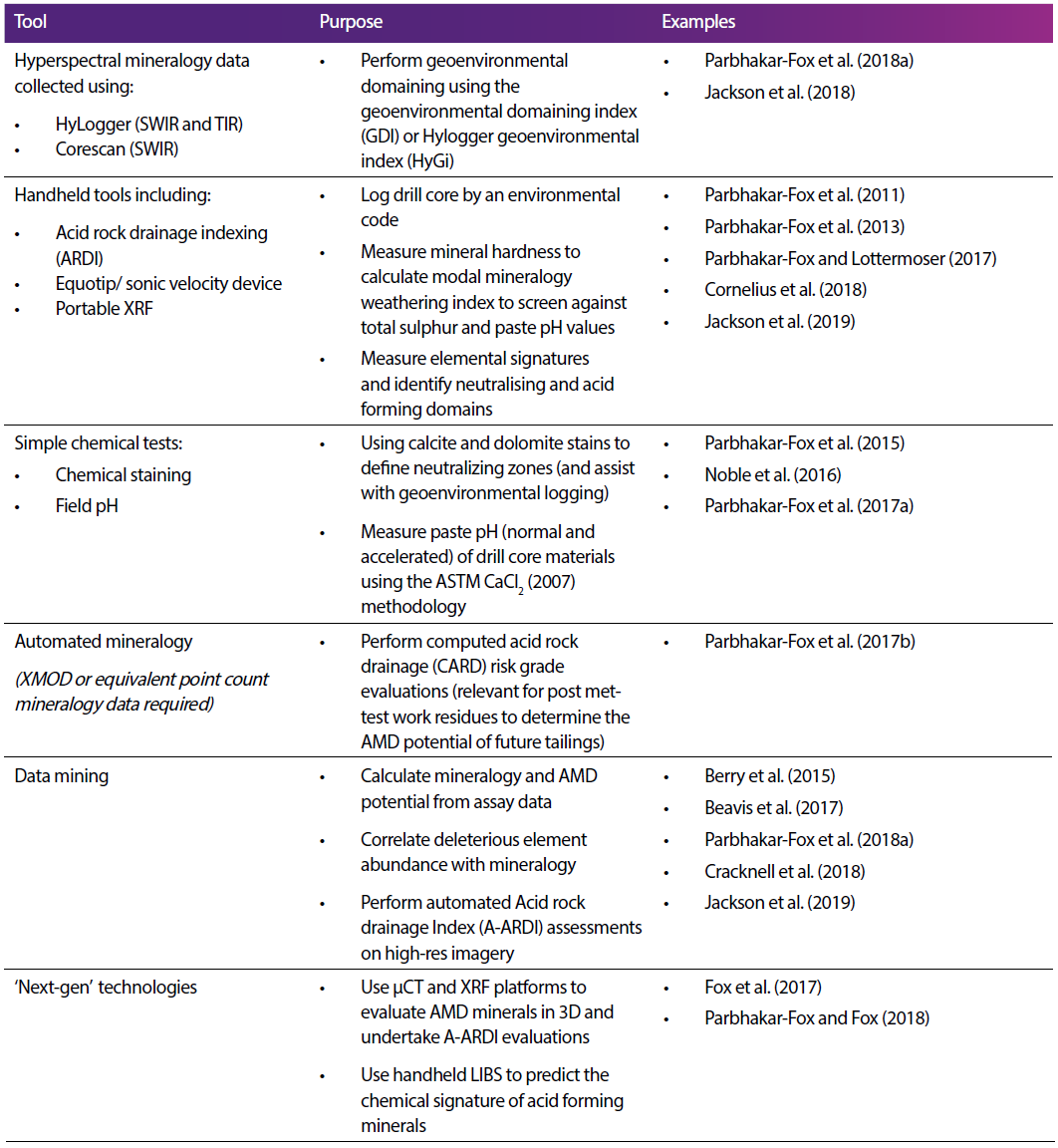
References
Brough, C., Strongman, J., Bowell, R., Warrender, R., Prestia, A., Barnes, A., Fletcher. J., 2017. Automated environmental mineralogy; the use of liberation analysis in humidity cell teswork. Minerals Engineering, v.107, p. 112-122.
Dold, B., 2017. Acid rock drainage prediction: A critical review. Journal of Geochemical Exploration, v. 172, p. 120-132.
Ernest Young: https://www.ey.com/en_gl/mining-metals/10-business-risks-facing-mining-and-metals (accessed 11th March, 2019).
Mudd, G.M., Jowitt, S.M., 2018. Global resource assessments of primary metals: An optimistic reality check. Natural Resources Research, v.27, p.229-240.
Qian, G., Schumann, R.C., Li, J., Short, M., Fan, R., Li, Y., Kawashima N., Zhou, Y., Smart, R., Gerson, A., 2017. Strategies for reducing acid and metalliferous drainage by pyrite surface passivation. Minerals, 7, 42, doi:10.3390/min7030042
Parbhakar-Fox, A and Fox, N and Jackson, L and Cornelius, R, “Forecasting geoenvironmental risks: Integrated applications of mineralogical and chemical data”, Minerals, 8 (12) Article 541. doi:10.3390/min8120541 ISSN 2075-163X (2018)
Jackson, L and Parbhakar-Fox, A and Fox, N and Meffre, S and Cooke, DR and Harris, A and Savinova, E, “Integrating hyperspectral analysis and mineral chemistry for geoenvironmental prediction”, Proceedings from the 11th International Conference on Acid Rock Drainage International Mine Water Association WISA Mine Water Division, 10-14 September 2018, Pretoria, South Africa, pp. 1075-1080. ISBN 9780620806503
Parbhakar-Fox, A and Edraki, M and Walters, S and Bradshaw, D, “Development of a textural index for the prediction of acid rock drainage”, Minerals Engineering: An International Journal Devoted to Innovation and Developments in Mineral Processing and Extractive Metallurgy, 24 (12) pp. 1277-1287. doi:10.1016/j.mineng.2011.04.019 ISSN 0892-6875 (2011)
Cornelius, R and Parbhakar-Fox, A and Cooke, DR, “A geoenvironmental characterisation tool for the coreshed during early life-of-mine assessments”, Proceedings of the Ninth Australian Workshop on Acid and Metalliferous Drainage, 20-23 November 2017, Burnie, Tasmania, pp. 102-113.
Parbhakar-Fox, A and Lottermoser, B and Bradshaw, DJ*, “Cost-effective means for identifying acid rock drainage risks: Integration of the geochemistry-mineralogy-texture approach and geometallurgical techniques”, Proceedings of the 2nd AusIMM International Geometallurgy Conference (GeoMet), 30 September - 2 October 2013, Brisbane, Australia, pp. 143-154. ISBN 9781921522970
Berry, R and Hunt, J and Parbhakar-Fox, A and Lottermoser, B, “Prediction of Acid Rock Drainage (ARD) from calculated mineralogy”, Proceedings of the 10th International Conference on Acid Rock Drainage and IMWA Annual Conference, 21-24 April 2015, Santiago, Chile, pp. 1-10. ISBN 978-956-9393-28-0
Parbhakar-Fox, A and Aalders, J and Lottermoser, B, “Effective field-based testing tools for rapid ARD prediction”, Proceedings of the 10th International Conference on Acid Rock Drainage and IMWA Annual Conference, 21-24 April 2015, Santiago, Chile, pp. 1-16. ISBN 978-956-9393-28-0
Cracknell, MJ and Parbhakar-Fox, A and Jackson, L and Savinova, E, “Automated acid rock drainage indexing from drill core imagery”, Minerals, 8 (12) Article 571. doi:10.3390/min8120571 ISSN 2075-163X
Fox, N and Parbhakar-Fox, A and Motlzen, J and Feig, S and Goemann, K and Huntington, J, “Applications of hyperspectral mineralogy for geoenvironmental characterisation”, Minerals Engineering, 107 pp. 63-77. doi:10.1016/j.mineng.2016.11.008 ISSN 0892-6875 (2017)
Parbhakar-Fox, A and Fox, N and Jackson, L and Cornelius, R, “Forecasting geoenvironmental risks: Integrated applications of mineralogical and chemical data”, Minerals, 8 (12) Article 541. doi:10.3390/min8120541 ISSN 2075-163X (2018b)
Noble, TL and Lottermoser, BG* and Parbhakar-Fox, A, “Evaluation of pH testing methods for sulfidic mine waste”, Mine Water and the Environment, 35 (3) pp. 318-331. doi:10.1007/s10230-015-0356-2 ISSN 1025-9112 (2016)
Parbhakar-Fox, A and Fox, N and Moltzen, J and Lottermoser, B, “Chemical Staining Techniques for Drill Core Characterization”, Environmental Indicators in Metal Mining, Springer International Publishing, B Lottermoser (ed), Switzerland, pp. 97-114. ISBN 978-3-319-42729-4 (2017a)
Parbhakar-Fox, A and Lottermoser, B, “Predictive Waste Classification Using Field-Based and Environmental Geometallurgy Indicators, Mount Lyell, Tasmania”, Environmental Indicators in Metal Mining, Springer International Publishing, B Lottermoser (ed), Switzerland, pp. 157-177. ISBN 978-3-319-42729-4 (2017)
Parbhakar-Fox, A and Lottermoser, B and Hartner, R* and Berry, RF and Noble, TL, “Prediction of Acid Rock Drainage from Automated Mineralogy”, Environmental Indicators in Metal Mining, Springer International Publishing, B Lottermoser (ed), Switzerland, pp. 139-156. ISBN 978-3-319-42729-4 (2017b)
Jackson, L and Maddocks, G and Long, P and Tear, S, “ Approach to building a geoenvironmental block model for the Walford Creek Project, AEON metals. The Australian Institute of Mining and Metallurgy (AUSIMM) PACRIM Conference, pp. 90-94. ISBN 978 1 925100 80 8
Parbhakar-Fox, A and Fox, N, “Final Report”, Establishing effective mineralogical and geochemical techniques for deposit-wide geoenvironmental characterisation: Laver, Sweden, Transforming the Mining Value Chain, April 2018, pp. 1-94.
Parbhakar-Fox, A and Lottermoser, BG, “A critical review of acid rock drainage prediction methods and practices”, Minerals Engineering, 82 pp. 107-124. doi:10.1016/j.mineng.2015.03.015 ISSN 0892-6875
Beavis, F., Taylor J., Winchester S., Tyler, M., Ehrig, K., Waters J. ‘Converting chemistry to mineralogy for acid and metalliferous drainage risk management In ‘Proceedings of the Ninth Australian Workshop on Acid and Metalliferous Drainage, Burnie, Tasmania. 20-23 November 2017. (Eds. Bell, L.C., Edraki, M. and Gerbo C.) pp. 14-21 (The University of Queensland: Brisbane).

